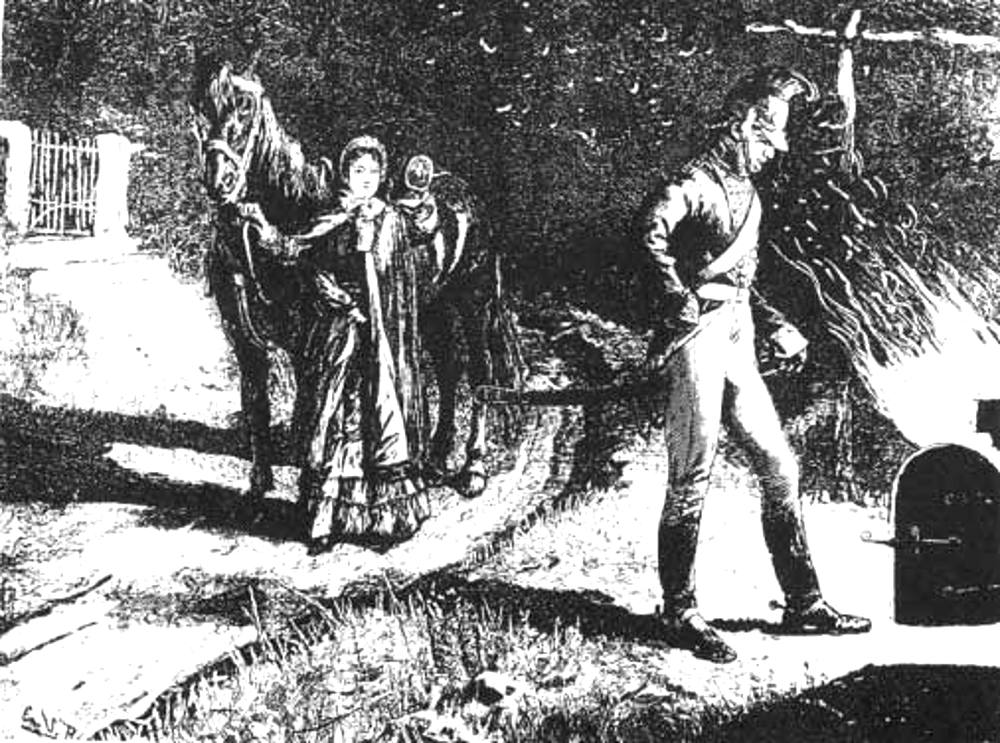
Jim stopped at the Kiln, while Mrs. Peach held the Horse by Charles S. Reinhart. 7 ½ x 9 ½ inches (18.5 cm high by 24.5 cm wide). Chapter Fifteen of Thomas Hardy's "Romantic Adventures of a Milkmaid" in The Graphic (Summer) 25 June 1883, 26.
Context of the Illustration: Parallel Temptation — Margery's Fiance and Mrs. Peach
In the meantime Jim and Mrs. Peach had walked slowly along the road together, Jim leading the horse, and Mrs. Peach informing him that her father, the gardener, was at Jim’s village further on, and that she had come to meet him. Jim, for reasons of his own, was going to sleep at his partner’s that night, and thus their route was the same. The shades of eve closed in upon them as they walked, and by the time they reached the lime-kiln, which it was necessary to pass to get to the village, it was quite dark. Jim stopped at the kiln, to see if matters had progressed rightly in his seven days’ absence, and Mrs. Peach, who stuck to him like a teazle, stopped also, saying she would wait for her father there.
She held the horse while he ascended to the top of the kiln. Then rejoining her, and not quite knowing what to do, he stood beside her looking at the flames, which to-night burnt up brightly, shining a long way into the dark air, even up to the ramparts of the earthwork above them, and overhead into the bosoms of the clouds.
It was during this proceeding that a carriage, drawn by a pair of dark horses, came along the turnpike road. The light of the kiln caused the horses to swerve a little, and the occupant of the carriage looked out. [Chapter XV, The Graphic, 21]
Commentary
The accompanying text, then, suggests that we are seeing what the Baron from his coach regards — a possible assignation between a handsome cavalryman and a comely widow only slightly his senior. Readers must wonder whether Margery will keep her engagement after all, or whether she will now encounter the Baron, the arrival of whose carriage here signals his return to the narrative. Reinhart has composed the scene to stimulate suspense. Mrs. Peach and the horse, for example, are much closer to Jim in the picture than in the letter-press, and the flames from the kiln emphasize Jim's attractiveness. He regards the flames rather than the widow, as if contemplating alternative futures, and mulling over Vine's scheme for him to win Margery back. Little does Jim realise (and the illustration does not suggest) that his nemesis, thought dead or cruising off the Algerian coast, has returned. Reinhart makes it clear that what we are seeing in the plate is exactly what Hardy has the Baron see:
It was during this proceeding that a carriage, drawn by a pair of dark horses, came along the turnpike road. The light of the kiln caused the horses to swerve a little, and the occupant of the carriage looked out. He saw the bluish, lightning-like flames from the limestone, rising from the top of the furnace, and hard by the figures of Jim Hayward, the widow, and the horse, standing out with spectral distinctness against the mass of night behind. The scene wore the aspect of some unholy assignation in Pandaemonium, and it was all the more impressive from the fact that both Jim and the woman were quite unconscious of the striking spectacle they presented. The gentleman in the carriage watched them till he was borne out of sight. [Chapter XV, 21]
Unfortunately, this final illustration, unmatched for clarity, economy, and suspense in the short series, was never seen by American readers. British readers, seeing this illustration, may well have felt that the Baron would justified in carrying Margery off from the fair since he will easily credit Margery's story of Jim's supposed infidelity.
Related material
Scanned image and text by Philip V. Allingham [You may use this image without prior permission for any scholarly or educational purpose as long as you (1) credit the person who scanned the image and (2) link your document to this URL in a web document or cite the Victorian Web in a print one.]
Bibliography
Allingham, Philip V. "The Original Illustrations for Thomas Hardy's The Romantic Adventures of a Milkmaid." The Thomas Hardy Journal 16, 3 (October, 2000): 45-62.
Hardy, Thomas. "The Romantic Adventures of a Milkmaid." Illustrated by C. S. Reinhart. The Graphic (Summer) June 25 1883: 23; Harper's Weekly (14 July 1883): 437.
Purdy, Richard Little, and Michael Millgate, eds. Collected Letters of Thomas Hardy, Oxford: Clarendon, 1978-88. Vol. I (1840-92), 1978.
Ray, Martin. Thomas Hardy: A Textual Study of the Short Stories. London: Ashgate, 1997.
Created 27 September 2007
Last modified 7 August 2020